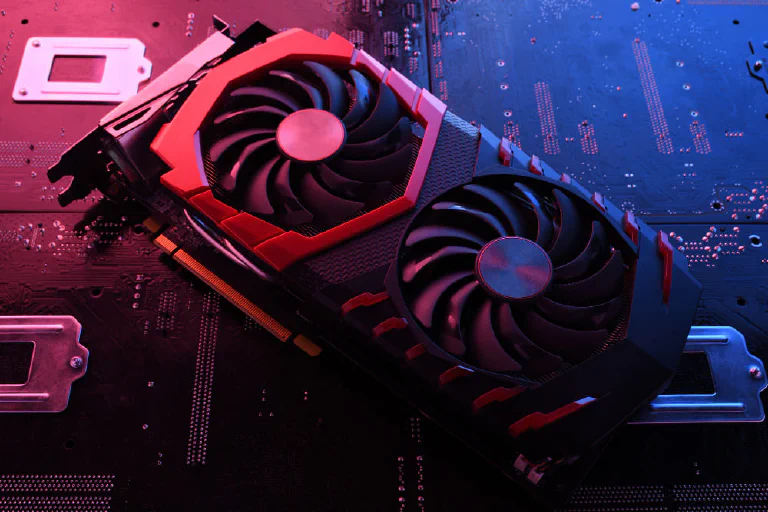For years, 1080p was the undisputed king of PC gaming. It was the resolution we all targeted, the standard that defined a generation of hardware. But as a PC builder who has been on the front lines of this industry for over a decade, I can tell you that in 2025, the king is dead. The great migration has happened, and 1440p (or 2K) is now the new standard for any serious gamer. The leap in visual clarity and immersion is simply too significant to ignore, and high-refresh-rate 1440p monitors are more affordable than ever.
This new standard, however, comes with a hefty price of admission: it demands a graphics card with serious muscle. Choosing the right GPU for 1440p is the most critical decision you’ll make for your gaming rig. It’s a complex balancing act between raw performance, smart AI-powered features, VRAM capacity, and, of course, your hard-earned money.
I’ve spent weeks analyzing the current generation of GPUs, digging through performance data from the new NVIDIA “Blackwell” and AMD “RDNA 4” architectures, and applying my own experience to distill it all into a clear, actionable guide. We’re going to break down the technologies that actually matter, analyze the top contenders for the 1440p crown, and help you make the smartest possible investment for years of high-fidelity gaming.

The New Rules of the Game: Decoding 2025 GPU Technology
Before we look at specific cards, you need to understand the new technological landscape. The metrics for a great GPU have changed.
The VRAM Question: 16GB is the New Sweet Spot
The “VRAM apocalypse” of recent years taught us a harsh lesson: insufficient video memory can cripple an otherwise powerful GPU. Modern game engines like Unreal Engine 5, with their massive, high-resolution textures, are incredibly memory-hungry. At 1440p with settings cranked up, I’ve seen games easily consume 10-12GB of VRAM.
My Rule for 2025: For a new 1440p build, do not consider a card with less than 12GB of VRAM. If you want your investment to last, 16GB is the true sweet spot that provides comfortable headroom for the next few years, and it’s a key feature of cards like the RTX 5070 Ti and RX 9070 XT.
The AI Co-Processor: Upscaling and Frame Generation
This is the single biggest innovation in modern GPUs. Instead of relying purely on brute force, these cards use dedicated AI hardware (Tensor Cores on NVIDIA, AI Accelerators on AMD) to run smart upscaling technologies.
- Upscaling (DLSS/FSR): The GPU renders the game at a lower internal resolution (like 1080p) and then uses a highly trained AI algorithm to intelligently reconstruct it to your target resolution (1440p). The result is a massive performance boost. The latest versions, DLSS 4 and FSR 4, have become incredibly refined, offering image quality that is often indistinguishable from native resolution.
- Frame Generation: This technology takes it a step further. It looks at two sequential frames, analyzes the motion, and then uses AI to generate an entirely new “fake” frame in between them, dramatically increasing the final FPS. The new Frame Generation on the RTX 50-series is particularly impressive, allowing for massive performance uplift.
Ray Tracing: No Longer a Gimmick
Ray tracing, which simulates the real-world behavior of light to create incredibly realistic shadows, reflections, and lighting, is now a mature and widely adopted feature. The performance cost is still significant, but when paired with smart upscaling, it’s a feature that truly elevates the visual experience. With the launch of the RTX 50-series and RX 9000-series, both NVIDIA and AMD now offer compelling hardware-accelerated ray tracing performance.
The Main Event: Analyzing the Top Contenders for the 1440p Crown
Based on the current 2025 market, the battle for the 1440p throne centers around a few key players from both Team Green and Team Red.
1. The AMD Challenger: Radeon RX 9070 XT
AMD has come out swinging with its RDNA 4 architecture. The RX 9070 XT is a testament to their focus on providing incredible rasterization (non-ray-traced) performance and generous memory configurations at a competitive price.
My analysis shows this card is a fantastic choice for gamers who prioritize raw framerates in traditional games. With a substantial 16GB of GDDR6 memory, it’s built to handle the most demanding textures at 1440p for years to come. AMD has also made huge strides in its ray tracing capabilities and now includes dedicated AI Accelerators that power their impressive FSR 4 upscaling technology. While FSR’s image quality is now very close to DLSS, NVIDIA still holds a slight edge in the maturity of its ray tracing ecosystem.
For a builder looking for incredible value, especially to pair with one of AMD’s excellent energy-efficient CPUs, the RX 9070 XT makes a powerful argument. It’s typically priced aggressively to undercut its direct NVIDIA competitor, often found in the $500-$600 range, making it a king of performance-per-dollar.
2. The Smart Choice: NVIDIA GeForce RTX 5070
The “70-class” card from NVIDIA is often the sweet spot for the majority of gamers, and the RTX 5070 from the new “Blackwell” family is no exception. It is the epitome of a smart, modern GPU.
Its key strength lies in its balance. It offers fantastic raw performance that will crush any game at 1440p, but its true magic is in its highly advanced Tensor Cores, which power the incredible DLSS 4 and Frame Generation features. In my experience, NVIDIA’s AI upscaling still holds a slight image quality advantage, and its ray tracing performance is second to none. With 12GB of fast GDDR7 memory, it’s well-equipped for modern titles.
This is the card I’d recommend for someone building a brand new, forward-looking PC who wants the best overall feature set and a highly polished experience. It’s also remarkably power-efficient for its performance class. Expect it to land in the $550-$650 price range. The best place to find these cards will be major retailers like Newegg and Amazon, as well as NVIDIA’s own website for their “Founders Edition” models.
3. The Powerhouse Value: NVIDIA GeForce RTX 4080 SUPER
Here’s where the decision gets tough and interesting for savvy builders. With the launch of the 50-series, the previous generation’s high-end RTX 4080 SUPER has seen significant price drops, placing it in direct competition with the new mid-range cards.
What you get with the 4080 SUPER is more raw hardware: more cores, more memory bandwidth, and a huge 16GB of GDDR6X VRAM. This brute-force power means it can often achieve higher frame rates at native 1440p resolution without even needing to rely on upscaling. For a gamer who prioritizes the purest possible image quality, this is a massive advantage. However, it’s a bigger, hotter, and more power-hungry card, and its DLSS 3 technology is a generation behind the RTX 5070’s DLSS 4.
If you can find an RTX 4080 SUPER on sale for around $700, it presents an incredible amount of raw performance for the money.
4. The 1440p Enthusiast’s Pick: NVIDIA GeForce RTX 5070 Ti
For the gamer who wants to push their high-refresh-rate 1440p monitor to its absolute limits, the RTX 5070 Ti is the answer. It takes the solid foundation of the RTX 5070 and adds more cores and faster memory, making it a significant step up in performance.
With a powerful 16GB of GDDR7 memory on a wider bus, this card is designed to never be memory-limited at 1440p. It’s the perfect GPU for a competitive player who wants 240+ FPS with DLSS in esports titles, or for the single-player enthusiast who wants to run fully ray-traced games with Frame Generation and maintain a locked 120 FPS. This level of performance typically comes at a premium, placing the RTX 5070 Ti in the $750-$850 price bracket.
5. The “No Compromises” 1440p Card: NVIDIA GeForce RTX 5080
Let’s be clear: the RTX 5080 is a 4K gaming card. However, for the gamer who wants to buy a GPU once and not think about upgrading for the next five years, using an RTX 5080 for a 1440p monitor is the ultimate form of future-proofing.
The sheer power of this card means it will run every game imaginable at 1440p at the highest possible settings, with incredible frame rates, for years to come. It has so much performance overhead that you’ll be able to run fully path-traced games with ease. It’s a massive investment, likely costing $1,000 or more, but it buys you peace of mind and the absolute best performance possible. For a top-tier build like this, you’ll need to consult a comprehensive guide like our Ultimate Custom PC Build Guide for 2025.
Best GPUs for 1440p Gaming in 2025!

The Final Render: Making Your 1440p Choice
After laying out the landscape, the choice for your 1440p build in 2025 comes down to a clear philosophy.
- For the Value-Focused Gamer: The Radeon RX 9070 XT offers the best raw performance for your dollar, especially if you prioritize traditional gaming over ray tracing.
- For the Smart, All-Around Builder: The GeForce RTX 5070 is the most balanced choice, offering a fantastic blend of modern features, efficiency, and powerful performance.
- For the Power-Seeking Enthusiast: The GeForce RTX 5070 Ti is the true sweet spot for high-refresh-rate 1440p gaming, while a discounted RTX 4080 SUPER offers an incredible amount of brute force for those who find a good deal.
No matter which path you take, you’ll be powering an incredible gaming experience. The 1440p era is here, and it’s a fantastic time to be a PC builder.
